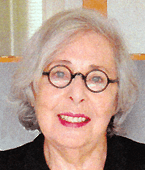Janika Fabrikant
Janika Fabrikant, a French-Swiss painter of urban and industrial landscapes, was born in Paris, France, in 1934.[1] She lives in Zürich, where her painting is prominent because of its special characteristic of cognitive dissonance. Her style, based on Surrealism, expresses a marked discrepancy between visual reality and terror.[2]
Janika Fabrikant | |
|---|---|
 | |
| Born | 1934 Paris, France |
| Nationality | French/Swiss |
| Website | Galerie Alex Schlesinger |
Career
From 1953-1955 she studied painting at the Académie de la Grande Chaumière. In 1961 she moved to Zurich, where she enrolled at the present Zurich University of the Arts (ZHdK) and studied painting from 1982-1985.
Her artistic development was inspired by visits to the U.S.A. where she felt a closer affinity to the contemporary art movements compared to Picasso and the Parisian avant garde, with which she had grown up. She was strongly influence by Edward Hopper and Milton Avery (1885-1965).[3] In Detroit Fabrikant discovered her theme [4] which she rendered in her characteristic synthetic colours, removed from nature. In 2013, one of her installations, The Butterfly, was selected as a finalist in the Waste•smART creative competition, run by the European Environment Agency the same year.[5]
Style
To reach out to Fabrikant's visual language some critics have attempted to categorize her style as “Visionary Precisionism”[6] or “Expressive Objectivity”[1] But her work is more complex. Although her paintings certainly have an element of American Precisionism, her irony, her sense of paradox, the monumentalization of the banal shows Fabrikant's roots in Pop Art.[7]
Since 1987 Fabrikant has participated in group exhibitions in Switzerland, France, the U.S.A. and one in China. For example, her work was selected to be showcased at the Exhibition 93. Union des Femmes peintres, sculpteurs, graveurs, decorateurs UFPS “Les Contemporaines” at the Grand Palais, in Paris (1993),[8] and she was profiled by World's Women On-Line.[9] Her work was presented at the Fourth United Nation's World Conference on Women in Beijing, China (1995), organized by artist Muriel Magenta at Arizona State University, Tempe, U.S.A. One of her paintings was selected for the electronic Space Art archive stored at the MIR Space Station, as a result of her participation in the Ars ad Astra Exhibit,[10] organized by the OURS Foundation.
Fabrikant's first solo exhibition was held in 1987.[4] In total she has had 12 solo exhibitions, mainly in Paris and Zurich. Her work is not only in private collections, but several paintings were acquired by the Bollag Galleries. Since 2010 she is represented by the Galerie Alex Schlesinger in Zurich.
Notes
- Affentranger-Kirchrat, Angelika. "Expressive Sachlichkeit: Janika Fabrikant bei Pérez Rojas". Neue Zürcher Zeitung 23 April 2007.
- Comp.Haftmann, Werner. Malerei im 20. Jahrhndert 1: Eine Entwicklungsgeschichte. Die Magische Dingerfahrung. Die Erfahrung des Absoluten (The Magic Experience of the Object). Munich, Prestel, 1954, p.190-240. See also: Sarane, Alexandrian. Surrealist Art. London, Thames & Hudson, 1970. Durozoi, Gerard. History of the Surrealist Movement, translated by Alison Anderson. University of Chicago Press, 2004. Nadeau, Maurice. History of Surrealism. Cambridge, Massachusetts, Bel Knap Press, 1989.
- Haskell, Barbara. Milton Avery. New York, Whitney Museum of American Art. Harper & Row, 1982.
- Kraft, Simone. Faszination urbaner Strukturen: Galerie Alex Schlesinger in Zürich. AZ/Architekturzeitung, 26. 2. 2010
- The European Environment Agency (EEA) headquartered in Copenhagen, Denmark, is an Agency of the European Union. It was established by the EEC (European Economic Community) and became functional in 1994.
- Solo Exhibition at the Galery “Zum grauen Wind” Zurich, 1995.
- Dieter Honisch/Jens Christian Jensen (ed) Amerikanische Kunst von 1945 bis heute (American Art from 1945 up to the Present). Berlin, DuMont, 1976, p. 37 ff.
- Canault, Janine. Les Contemporaines, 109-ième Salon de L'Union des Femmes Peintres & Sculpteurs. Grand Palais, Paris, France, 1993: 182-183.
- Janika Fabrikant, The World's Women Online. Retrieved 2014-08-23.
- See Ars ad Astra: The first Art Exhibition in Earth Orbit. Art Works selected for the Electronic Archive on Euromir 95
References
- ANGELI, Bruno. Zwischen Pinsel und Pedalen. (Between paintbrush and pedals: The theme of the bicycle in Janika Fabrikant's painting). Velojournal 3, Zurich, 2011: 61.
- ANONYMOUS under “Diese Woche”. Unbestechliche Wahrnehmung (Incorruptible perception). Tachles, (Weekly Newspaper) Zurich, 27 April 2007.
- BEN YOSEF, Ute. Menschlich fabrizierte Maschinenlandschaften. J. Rundschau Maccabi, (Weekly Newspaper) Basle (Switzerland), 21 November 1991.
- BEN YOSEF, Ute. Janika Fabrikant stellt in Paris aus. J. Rundschau Maccabi, Basel, 17 September 1992.
- BEN YOSEF, Ute. Janika Fabrikant: Schoene Neue Welt und Kognitive Dissonanz. Zurich, Galerie Alex Schlesinger 2014. ISBN 978-3-033-04862-1.
- BERG, Vivianne. Fabriken in Farben, die sich beissen (Factories in clashing colours). I. Wochenblatt (Weekly Newspaper) 48, Zurich, 1 December 1995.
- ROSENBERG, Gabi. Schönheit als Sinnbild des Bösen (Beauty as symbol of evil). J. Rundschau Maccabi, (Weekly Newspaper) Basle, 4 January 1996.
External links
- Clara database of women artist, Library and Research Center of the National Museum of Women in the Arts, Washington DC.
- european-art.net database, Zurich.
- Janika Fabrikant at the Bollag Galleries 2008-2010, Zurich, Switzerland.
- SIKART Lexicon on art in Switzerland, Swiss Institute for Art Research.
- VISARTE.SWITZERLAND, visual arts association - Switzerland, formerly GSMBA (Society for Swiss painters, sculptors and architects).
- Janika Fabrikant at the Gallery Alex Schlesinger since 2010 in Zurich, Switzerland.